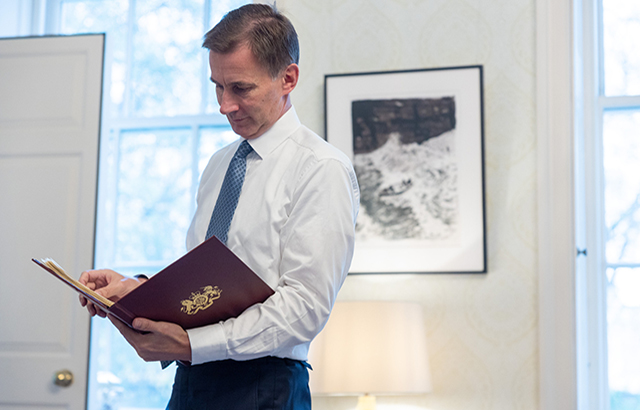UK chancellor of the exchequer Jeremy Hunt has announced an array of fiscal measures, including tax cuts and extended threshold freezing, in his Autumn Statement.
The decisions were driven to calm the markets after frantic outcomes of Kwasi Kwarteng’s September ‘mini-budget’, but also as a way to tackle the 41-year-record high inflationary environment, cost of living and energy crises.
Among the worthiest of note changes were those made to the inheritance tax (IHT) and capital gains tax (CGT) regimes.
IHT thresholds had previously been frozen by then chancellor Rishi Sunak in March 2021 until 2025-26. Hunt has now taken the measure a step further announcing the limits will remain frozen by an additional two years until April 2028.
The ‘deep freeze’, as platform AJ Bell called it, means that the IHT threshold will have remained the same for nearly two decades as it will stay at its 2009 level.
More specifically, the nil-rate band will remain at £325,000 and the residence nil-rate band at £175,000, with the residence nil-rate band taper continuing to start at £2m ($2.4m, €2.3m). Qualifying estates will still be able to pass on up to £500,000 and the qualifying estates of a surviving spouse or civil partner can pass on up to £1m without incurring any IHT liabilities.
Stealth tax on wealth transfers
Faye Church, chartered financial planner at Investec Wealth & Investment, said: “[IHT] is an unpopular tax, where promised reform is usually part of any leadership or election bid. It is a complex area and simplification would be welcomed.
“In the meantime, we are regularly advising clients how to plan to reduce their inheritance tax liability. Cash flow planning helps us ring-fencing assets that may be called upon within a client’s lifetime, in turn identifying assets that are surplus to requirements. The benefit to this to the client is that monies can be gifted within their lifetime so they can see their families enjoy them, rather than pass on via their Will”.
Julia Rosenbloom, tax partner at Evelyn Partners, added: “The freezing of both nil-rate bands has already seen receipts from IHT grow rapidly, thanks to the effects of asset price inflation. Not only do more families with unremarkable levels of wealth get drawn into the IHT net, but those estates that would expect to exceed the threshold see more and more of their assets subject to taxation.
“Extending the main threshold freeze to 2028 will entrench nearly 20 years of stealth tax increases on the transfer of wealth and means ever more modest estates are facing tax liabilities. Even if asset prices moderate during that period, more IHT will be paid than if thresholds had been increased with inflation.
“As for the residence nil-rate band, while its introduction in 2017 reduced the reach of IHT for a few years, that trend has turned around thanks in part to soaring property prices across the country. The average house price in the UK has nearly doubled since April 2009.
“Families who find that the freeze means their assets are being dragged over the IHT threshold can take some relatively easy steps to stay the right side of it, or to mitigate liability. These include making a Will, using allowances smartly, lifetime gifting and putting life assurance policies into trust.
“Not only will it save the next generation from overpaying tax on the transfer of wealth but it could also prevent some admin headaches at probate – especially as the IHT bill usually has to be settled before the estate’s assets can be liquidated and disbursed.”
Capital gains tax
On the CGT front, the widely rumoured reform of bringing rates in line with income tax has failed to materialise yet again. But, in turn, Hunt announced two significant cuts to the CGT annual exempt figure.
The tax-exempt sum will be slashed from the current £12,300 to £6,000 from April 2023, and a further 50% cut to £3,000 from April 2024, bagging the Treasury over £1.2bn a year from 2025.
The cuts came alongside a reduction of the dividend allowance as well, also halved from £2,000 to £1,000 from April 2023, which some industry players believe is going to hurt small investors the most.
Charles Incledon, client director at Bowmore Asset Management, said: “The cut in the dividend allowance and CGT threshold is a double whammy against investors. Whilst high net worth individuals are unlikely to feel much pain from this, for many small investors that increase in tax on dividends and capital gains is going to be significant.
“Cuts to this income could cause a real squeeze on the finances of many small investors, especially those who are retired and depend on dividend income from their shares. Bad news considering that we have a cost of living crisis at the moment.”
But Chris Springett, tax partner at Evelyn Partners, believes that those impacted – although few – will probably be able to find a way around the changes.
“Most CGT comes from a small number of taxpayers who make large gains. The halving of the allowance increases the burden on investors and property owners at the other end of the CGT spectrum – those who have made relatively modest gains but are nevertheless drawn across a much-reduced threshold.
“Moreover, these taxpayers may need to file tax returns for the first time to report capital gains, causing a new admin headache. Also, capital gains can be deferred, as owners of assets can put off a sale in order to stave off a CGT liability, so the cut in the CGT exemption might raise less than Hunt is hoping.
“What this does for all taxpayers, is make the case for holding investments in wrappers that afford tax protection even more compelling than it is already. Investments held in ISAs and pensions are exempt from CGT – which is why many investors never encounter the tax.
“And it is a reminder of the sense in using allowances effectively. In terms of reducing CGT exposure, married couples and those in civil partnerships can transfer assets to each other – known as an interspousal transfer – to make use of both sets of allowances, as well as shift a potential gain to whichever partner might be exposed to a lower tax band.”
Tax avoidance fight
As part of the plethora of measures unveiled by Hunt on 17 November 2022, additional funding and legislation will be put in place to fight tax avoidance from wealthy individuals.
The government will set out that shares and securities in a non-UK company acquired in exchange for securities in a UK close company “will be deemed to be located in the UK”.
Additionally, HM Revenue & Customs (HMRC) will receive a further £79m over the next five years to “allocate additional staff to tackle more cases of serious tax fraud and address tax compliance risks among wealthy taxpayers”.
The Treasury forecasts the measure to bring in a further £725m of additional tax revenues over the next five years.
“The government remains committed to ensuring HMRC has sufficient funding to enable it to maintain its compliance performance over time, while continuing to make efficiencies, both in this and future spending review periods.”








